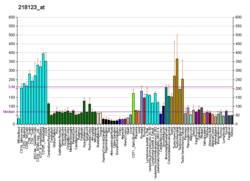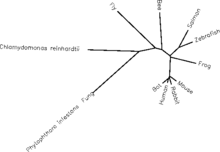C21orf59
| C21orf59 | |||||||
|---|---|---|---|---|---|---|---|
| Identifiers | |||||||
| Aliases | C21orf59, C21orf48, CILD26, FBB18, Kur, chromosome 21 open reading frame 59 | ||||||
| External IDs | MGI: 1915251 HomoloGene: 10941 GeneCards: C21orf59 | ||||||
| RNA expression pattern | |||||||
 | |||||||
| More reference expression data | |||||||
| Orthologs | |||||||
| Species | Human | Mouse | |||||
| Entrez | |||||||
| Ensembl | |||||||
| UniProt | |||||||
| RefSeq (mRNA) | |||||||
| RefSeq (protein) | |||||||
| Location (UCSC) | Chr 21: 32.59 – 32.61 Mb | Chr 16: 90.93 – 90.93 Mb | |||||
| PubMed search | [1] | [2] | |||||
| Wikidata | |||||||
| |||||||
C21orf59 is a protein of unknown function. It is of interest in part for its association with various diseases. It has been found in high levels in the bone marrow of patients with a negative prognosis of acute myeloid leukemia and an abnormal karyotype.[3][4][5] Male Alzheimer's patients have shown a decrease in expression of C21orf59 in their blood cells.[6][7] The C21orf59 gene lies within the critical region of Down Syndrome.[8] There are no clear paralogs in humans, but the gene has homologues widely conserved among animals, fungi, and algae.

Gene
C21orf59 is a gene found on the 21st chromosome at 21q22.1. A total of thirteen splice variants have been found, but only eleven protein coding ones.[9] The most common form of C21orf59 mRNA has 1427 base pairs broken into seven exons. Its closest neighbors on the chromosome are TCP10L, FAM176C, LOC100506185, OR7E23P, and SYNJ1.
Gene Expression
The C21orf59 primary sequence is found in high quantity in most tissues. Some tissues with notable less expression are the ganglions, the heart, and the liver.[10] It is suspected C21orf59 is found in the brain early in development due to the two achaete-scute complex homologue transcription factor binding sites found in the promoter.[11]
Protein
The C21orf59 primary sequence consists of 290 amino acids with mass 33.093 kDa. The isoelectric point is 7.283, but is reduced to 5.86 if fully phosphorylated.[12] Several post-translational modifications have been found by mass spectroscopy: five phosphorylation sites, one methylation site, one ubiquitination site, and one acetylation site.[12] Most of these modifications happen in the latter half of the protein.
Structure
The majority of the protein consists of the domain DUF2870. This domain is primarily found in homologues of C21orf59, but also in other uncharacterized proteins,[13] and it contains the majority of the sites that are modified after translation. The protein is predicted to consist mostly of alpha helices and lack beta strands.[14]
Localization
C21orf59 has been shown to localize to the cytosol and the nucleus,[15] but has been predicted, albeit with less strength, to localize to the cytoskeleton, peroxisome, and the mitochondria.[16]
Interactions
Through mass spectrometry, interactions with SUMO2,[17] a post-translational modification protein resembling ubiquitin, and Ubiquitin C[18] have been identified. Through two-hybrid experiments, an interaction with MAPK6, a protein kinase, has been found.[19]
Recent Studies
A study in zebrafish has shown C21orf59 is found in high concentrations in the Kupffer vesicles, and is intracellularly localized to the basal body of the cilia.[20] Zebrafish mutant in C21orf59 homologue have defects in ciliary motility,.[20] Additionally, motile cilia in zebrafish and xenopus c21orf59 mutants are immotile and mispolarized, suggesting c21orf59 plays roles in planar cell polarity as well as ciliary motility.[21]
References
- ↑ "Human PubMed Reference:".
- ↑ "Mouse PubMed Reference:".
- ↑ Bullinger L, Döhner K, Bair E, Fröhling S, Schlenk RF, Tibshirani R, Döhner H, Pollack JR (April 2004). "Use of gene-expression profiling to identify prognostic subclasses in adult acute myeloid leukemia". N. Engl. J. Med. 350 (16): 1605–16. PMID 15084693. doi:10.1056/NEJMoa031046.
- ↑ Greiner J, Schmitt M, Li L, Giannopoulos K, Bosch K, Schmitt A, Dohner K, Schlenk RF, Pollack JR, Dohner H, Bullinger L (December 2006). "Expression of tumor-associated antigens in acute myeloid leukemia: Implications for specific immunotherapeutic approaches". Blood. 108 (13): 4109–17. PMID 16931630. doi:10.1182/blood-2006-01-023127.
- ↑ Bullinger L, Ehrich M, Döhner K, Schlenk RF, Döhner H, Nelson MR, van den Boom D (January 2010). "Quantitative DNA methylation predicts survival in adult acute myeloid leukemia". Blood. 115 (3): 636–42. PMID 19903898. doi:10.1182/blood-2009-03-211003.
- ↑ Maes OC, Xu S, Yu B, Chertkow HM, Wang E, Schipper HM (December 2007). "Transcriptional profiling of Alzheimer blood mononuclear cells by microarray". Neurobiol. Aging. 28 (12): 1795–809. PMID 16979800. doi:10.1016/j.neurobiolaging.2006.08.004.
- ↑ Maes OC, Schipper HM, Chertkow HM, Wang E (June 2009). "Methodology for discovery of Alzheimer's disease blood-based biomarkers". J. Gerontol. A Biol. Sci. Med. Sci. 64 (6): 636–45. PMID 19366883. doi:10.1093/gerona/glp045.
- ↑ Moncaster JA, Pineda R, Moir RD, Lu S, Burton MA, Ghosh JG, Ericsson M, Soscia SJ, Mocofanescu A, Folkerth RD, Robb RM, Kuszak JR, Clark JI, Tanzi RE, Hunter DG, Goldstein LE (2010). "Alzheimer's disease amyloid-beta links lens and brain pathology in Down syndrome". PLoS ONE. 5 (5): e10659. PMC 2873949
 . PMID 20502642. doi:10.1371/journal.pone.0010659.
. PMID 20502642. doi:10.1371/journal.pone.0010659. - ↑ Ensembl http://ensembl.org
- ↑ C21orf59 GDS596 GEOprofile
- ↑ Genomatix http://www.genomatix.de
- 1 2 Phosphosite
- ↑ Conserved Domains
- ↑ SDSC PELE
- ↑ Hu YH, Warnatz HJ, Vanhecke D, Wagner F, Fiebitz A, Thamm S, Kahlem P, Lehrach H, Yaspo ML, Janitz M (2006). "Cell array-based intracellular localization screening reveals novel functional features of human chromosome 21 proteins". BMC Genomics. 7: 155. PMC 1526728
 . PMID 16780588. doi:10.1186/1471-2164-7-155.
. PMID 16780588. doi:10.1186/1471-2164-7-155. - ↑ PsortII http://www.psort.org/
- ↑ Golebiowski, F.; Matic, I.; Tatham, M. H.; Cole, C.; Yin, Y.; Nakamura, A.; Cox, J.; Barton, G. J.; Mann, M.; Hay, R. T. (2009). "System-Wide Changes to SUMO Modifications in Response to Heat Shock". Science Signaling. 2 (72): ra24. PMID 19471022. doi:10.1126/scisignal.2000282.
- ↑ Kim, W.; Bennett, E. J.; Huttlin, E. L.; Guo, A.; Li, J.; Possemato, A.; Sowa, M. E.; Rad, R.; Rush, J.; Comb, M. J.; Harper, J. W.; Gygi, S. P. (2011). "Systematic and Quantitative Assessment of the Ubiquitin-Modified Proteome". Molecular Cell. 44 (2): 325–340. PMC 3200427
 . PMID 21906983. doi:10.1016/j.molcel.2011.08.025.
. PMID 21906983. doi:10.1016/j.molcel.2011.08.025. - ↑ Vinayagam, A.; Stelzl, U.; Foulle, R.; Plassmann, S.; Zenkner, M.; Timm, J.; Assmus, H. E.; Andrade-Navarro, M. A.; Wanker, E. E. (2011). "A Directed Protein Interaction Network for Investigating Intracellular Signal Transduction". Science Signaling. 4 (189): rs8. PMID 21900206. doi:10.1126/scisignal.2001699.
- 1 2 Schottenfeld, J. 2008. The role of PKD2 and C21ORF59 in patterning the left-right axis of the zebrafish embryo. (Doctoral dissertation). Retrieved from ProQuest Dissertations and Theses. (Accession Order No. AAT 3308052.)
- ↑ http://www.cell.com/cell-reports/pdf/S2211-1247(16)30062-6.pdf
External links
- Human C21orf59 genome location and C21orf59 gene details page in the UCSC Genome Browser.
Further reading
- Denoeud F, Kapranov P, Ucla C, et al. (2007). "Prominent use of distal 5' transcription start sites and discovery of a large number of additional exons in ENCODE regions.". Genome Res. 17 (6): 746–59. PMC 1891335
 . PMID 17567994. doi:10.1101/gr.5660607.
. PMID 17567994. doi:10.1101/gr.5660607. - Hu YH, Warnatz HJ, Vanhecke D, et al. (2006). "Cell array-based intracellular localization screening reveals novel functional features of human chromosome 21 proteins.". BMC Genomics. 7: 155. PMC 1526728
 . PMID 16780588. doi:10.1186/1471-2164-7-155.
. PMID 16780588. doi:10.1186/1471-2164-7-155. - Rush J, Moritz A, Lee KA, et al. (2005). "Immunoaffinity profiling of tyrosine phosphorylation in cancer cells.". Nat. Biotechnol. 23 (1): 94–101. PMID 15592455. doi:10.1038/nbt1046.
- Gerhard DS, Wagner L, Feingold EA, et al. (2004). "The status, quality, and expansion of the NIH full-length cDNA project: the Mammalian Gene Collection (MGC).". Genome Res. 14 (10B): 2121–7. PMC 528928
 . PMID 15489334. doi:10.1101/gr.2596504.
. PMID 15489334. doi:10.1101/gr.2596504. - Ota T, Suzuki Y, Nishikawa T, et al. (2004). "Complete sequencing and characterization of 21,243 full-length human cDNAs.". Nat. Genet. 36 (1): 40–5. PMID 14702039. doi:10.1038/ng1285.
- Strausberg RL, Feingold EA, Grouse LH, et al. (2003). "Generation and initial analysis of more than 15,000 full-length human and mouse cDNA sequences.". Proc. Natl. Acad. Sci. U.S.A. 99 (26): 16899–903. PMC 139241
 . PMID 12477932. doi:10.1073/pnas.242603899.
. PMID 12477932. doi:10.1073/pnas.242603899. - Suzuki Y, Yoshitomo-Nakagawa K, Maruyama K, et al. (1997). "Construction and characterization of a full length-enriched and a 5'-end-enriched cDNA library.". Gene. 200 (1-2): 149–56. PMID 9373149. doi:10.1016/S0378-1119(97)00411-3.
- Maruyama K, Sugano S (1994). "Oligo-capping: a simple method to replace the cap structure of eukaryotic mRNAs with oligoribonucleotides.". Gene. 138 (1-2): 171–4. PMID 8125298. doi:10.1016/0378-1119(94)90802-8.